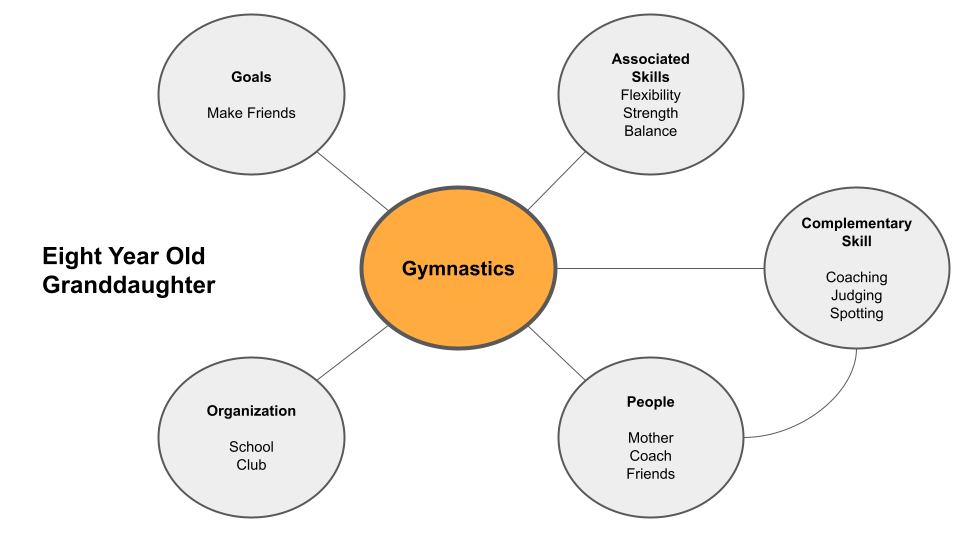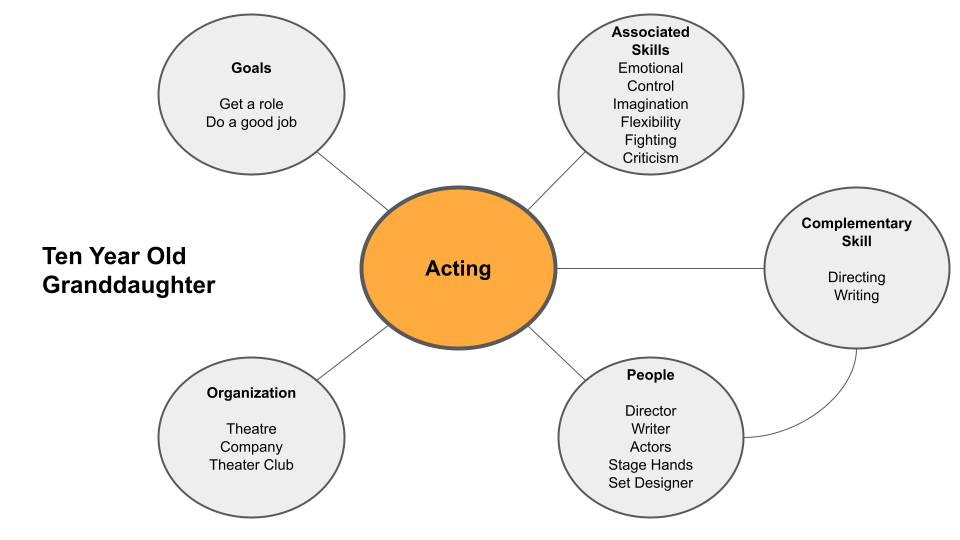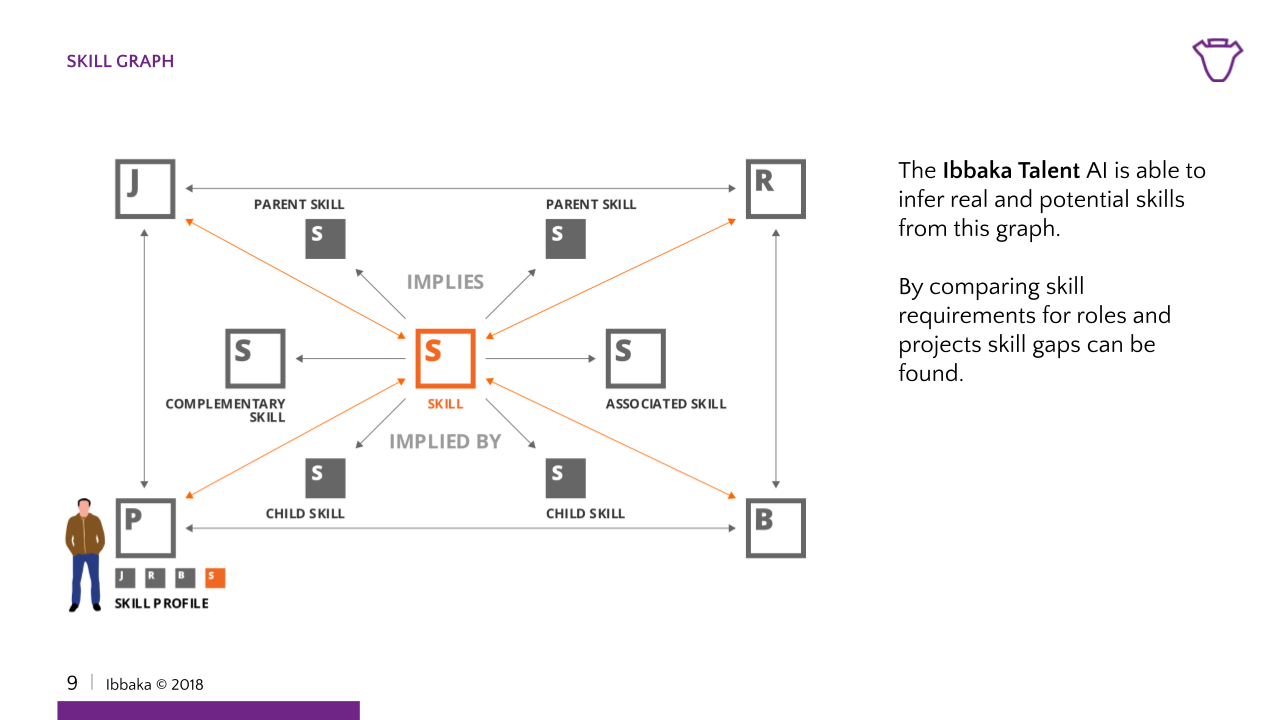How to connect your skills
Steven Forth is co-founder and managing partner at Ibbaka. See his skill profile here.
For the past few months I have been coaching my ten year old granddaughter on math. I am sure I am learning as much as she is. One thing we have been doing working on rote memorization of the multiplication and division tables. I know memorization is not real learning, but for basic math, I find it a great enabler. We have also been programming multiplication and division into a spreadsheet. She enjoys using spreadsheets (she uses them to track the characters in the stories she writes) and this gives her a chance to work on some basic skills while getting a feel for the number plane.
What has been most fun, though, has been working with her on concept maps. A concept map is a simple graph of the relationships between different concepts. There could be a concept ‘number’ that connects to ‘negative number’ and ‘ positive number.’ From there we could get to ‘number line’ and from ‘number line’ to combining two number lines to create a ‘plane.’ The concept of ‘addition’ leads to ‘multiplication’ and on and on. The concepts and the connections between them can even be color coded to make the whole thing more fun and to help patterns pop out.
We got this idea from the wonderful Mindful Mathematics series, led by Jo Boaler at Stanford, see What is Mathematical Beauty? Teaching through Big Ideas and Connections.
Skills get connected to many different things. Part of the power of skill management comes from making and managing these connections. Skills connect to other skills, to people, to roles and to goals. Spend 15 minutes thinking about new ways you can connect your skills.
At an abstract level the connections between skills look like this.
I was working on this post when my granddaughters showed up. The younger one said she could finish this for me. She is eight and she wants to do more gymnastics.
The older one (who I coach on math) is more interested in acting.
Connecting skills to skills
One place to start when connecting skills is with other skills. The Ibabka platform does this for you in the background, but it is useful to sketch this out for yourself. Pick one skill you are interested in and ask the following three questions.
What other skills do I use with this skill?
What skills could I add that would make me better with this skill?
What skills can I ‘borrow’ from other people that would help me put this skill to work?
An example …
Pattern Recognition is an important foundational skill (a foundational skill is a skill that we use to build other skills). In my case, it is supported by abstraction (another foundational skill) and by sketching (a design skill).
Skills extend out in a network with one each skill supporting other skills.
Connecting skills to roles
We do not develop skills for the sake of having more and more skills. We use our skills to accomplish work. At Ibbaka, we see the future of work as being team based and role based. There are several different types of roles to consider.
Job Roles - a job can be thought of as a bundle of roles
Team or Project Roles - many of us play different roles on different teams
Ad-Hoc Roles - sometimes we are asked to
Community Roles - not everything we do is part of work, many of us play important roles in our community
There are lots of questions you could ask yourself about skills and roles.
What roles do I play today?
What skills do I use in those roles?
What skills would help me perform better?
What roles do I want to play?
What skills do I need to play these roles?
This approach can be taken at the individual, team and organizational levels.
Connecting skills to goals
One powerful way to make skills meaningful is to connect them to goals. One way to do this is to build a skill or competency model for your goals (see How to align skills and competencies with goals).
Performing well in a current role or aspiring to a new role is one example of a goal, but there are many others at the individual, team and organizational levels.
Understanding the skills we need to achieve our goals is central to skill management. It answers the ‘why’ question, ‘Why invest so much time and energy into managing skills?’ The answer is that you will not achieve your goals without attention to skills.
One trap to avoid is the assumption that it is only one’s own skills that matter. Most goals require the efforts of more than one person. The skills we need to achieve our goals are often connected to other people.
Connecting skills to people
This is the most important thing.
Our skills connect us to other people. They do this in many different ways. Our managers and peers are of course concerned with the skills we have, how we are using them, and the skills we are targeting for development.
Coaches and mentors also play a critical role in skill development and application. The best athletes get the best coaches. Part of skill management is to connect coaches and mentors to people to improve performance.
Whole communities can develop around specific skills. Design thinking is supported by a global community of people of all skill levels and interests. There are more than 180,000 people in the LinkedIn Design Thinking Group that Ibbaka manages.
One of Ibbaka’s long term goals is to develop skill based communities.
The skill graph
Under the hood, skills get connected through the skill graph. The skill graph is a data structure that underlies skill management. It connects skills, people, roles, goals in a way that supports all sorts of advanced functionality, from search, to skill extraction from unstructured documents, to suggesting skills to individuals and for roles and teams.
Ibbaka posts on competency models and competency frameworks
How to align competencies with goals (this post)
Competency models as learning plans (this post)
From user experience to competency model design - Margherita Bacigalupo and EntreComp
Competency framework designers on competency framework design: The chunkers and the slice and dicers
Competency framework designers on competency framework design: Victoria Pazukha
Design research - How do people approach the design of skill and competency models?
The Skills for Career Mobility - Interview with Dennis Green
Lessons Learned Launching and Scaling Capability Management Programs
Talent Transformation - A Conversation with Eric Shepherd, Martin Belton and Steven Forth
Individual - Team - Organizational use cases for skill and competency management
Co-creation of Competency Models for Customer Success and Pricing Excellence
Competencies for Adaptation to Climate Change – An Interview with Dr. Robin Cox
Architecting the Competencies for Adaptation to Climate Change Open Competency Model
Integrating Skills and Competencies in the Talent Management Ecosystem
Organizational values and competency models – survey results














